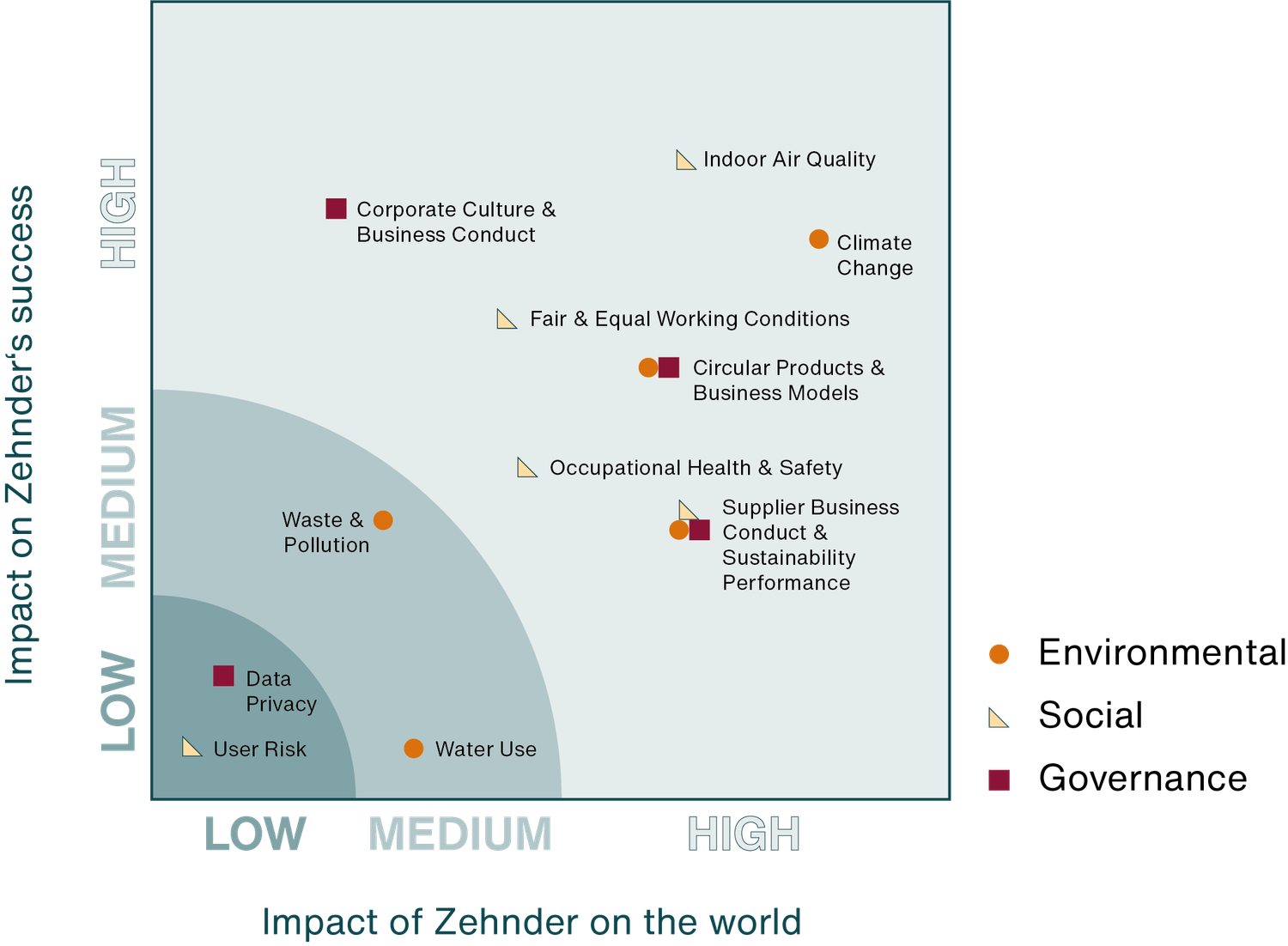Strategy
Materiality and stakeholder analysis
Materiality analysis
In 2023, Zehnder conducted a Double Materiality Assessment in line with ESRS and European Financial Reporting Advisory Group (EFRAG) guidelines. Potentially material topics were identified from ESRS General Requirements, the UN SDGs, and internal insights. This initial list of over 80 items was refined through internal discussions and consensus to 21 final material topics.
To ensure inclusivity, 63 stakeholders – including employees, suppliers, customers, and Board members – were interviewed across multiple languages. Participants identified key topics and classified them as positive or negative impacts, risks, or opportunities based on their professional expertise. Materiality was rated on a 1-to-5 scale for likelihood and severity (for impacts) or financial effect (for risks/opportunities), considering mid-term changes (five to ten years). The final analysis balanced stakeholder insights with internal priorities, avoiding bias from frequently mentioned topics.
The collected data was analysed to assess impact and financial materiality, shaping Zehnder’s sustainability strategy and resulting in a materiality matrix.
In 2024, Zehnder expanded its efforts by conducting a detailed TCFD analysis to evaluate climate-related risks and opportunities. This deepened our understanding of the financial implications of climate change. As a result, we integrated these insights into our strategy, and bolstered resilience against climate impacts, further strengthening our commitment to proactive climate action.
Building on these insights, the materiality assessment continues to guide how we prioritise and address sustainability topics, ensuring alignment with stakeholder expectations and internal objectives.
Feedback from leadership led to a reassessment and refinement of specific subtopics to enhance prioritisation and effectiveness. This included validating the data collection process and reorganising impacts, risks, and opportunities into more relevant categories, resulting in clearer priorities. A benchmark against industry peers confirmed alignment with sector best practices.
Key adjustments included merging overlapping topics for the sake of simplicity, renaming “User Safety” to “User Risk” for clarity, and adding “Indoor Air Quality” to reflect its importance to stakeholders. “Biodiversity” was removed as a standalone topic due to low financial and impact materiality, with its relevance integrated into related areas like “Waste & Pollution” and “Water Use,” aligning with the ESRS focus on direct impacts.
The updated materiality matrix was refined for clarity, and visually enhanced, ensuring alignment with leading practices in sustainability reporting.
Materiality Matrix

Indoor Air Quality is a key topic, offering significant benefits to customers by enhancing health and comfort through our products. Stakeholders consistently emphasised its importance during interviews. However, as it aligns closely with our core business purpose rather than representing a distinct sustainability challenge, it is not explored in detail in this report.
Our other material topics are thoughtfully integrated and reflected throughout the report as follows:
- Climate action: Climate Change is addressed through our emissions, energy savings via heat recovery ventilation, and strategies to manage physical and transition risks.
- Resource-efficient production: Covers Waste & Pollution management, including packaging, scrap, and hazardous chemicals, and addresses Water Use at key production sites.
- Circular products and innovation: Emphasises Circular Products & Business Models including repairability, sustainable materials and renovation-friendly solutions.
- Occupational health and safety: Prioritises the well-being of employees, especially in production environments with a strong focus on Occupational Health & Safety.
- Attractive employer: Highlights initiatives to boost employee engagement and a supportive workplace culture.
- Diversity, equal opportunity, inclusion, and decent work: Addresses Fair & Equal Working Conditions, including pay equity, diversity and inclusion, and anti-harassment measures.
- Sustainable purchasing: Focuses on Supplier Business Conduct & Sustainability Performance, emphasising alignment with our ethical standards.
- Compliance and fair business practices: Promotes Corporate Culture & Business Conduct by fostering transparency and compliance while preventing unethical practices.
- Upholding human rights: Covers risks and due diligence efforts to ensure fair treatment in operations and supply chains.
Stakeholder analysis
We identify our stakeholder categories by assessing their relevance to our operations, their influence on our business, and the potential impact of our activities on them. Stakeholders include individuals and organisations with financial, legal, ethical, or environmental expectations of Zehnder Group. This assessment is informed by consultations with internal teams across different branches to compile a comprehensive list. We then prioritise these stakeholders based on their significance to our sustainability goals, focusing on key groups such as employees, customers, suppliers, investors, financial analysts, rating agencies, and non-governmental organisations.
The primary aim of our stakeholder engagement is to gather insights that align our sustainability strategy with the expectations and concerns of those directly or indirectly affected by our activities. This engagement helps us pinpoint critical sustainability topics, identify potential risks and opportunities, and ensure that our actions are both socially responsible and environmentally sustainable. Transparent communication enhances decision-making, fosters trust, and builds lasting relationships.
Communication with stakeholder groups
We engage with our diverse stakeholder groups through structured and inclusive approaches that are vital to advancing our sustainability goals. Our tools and channels to communicate with our stakeholders include:
- Interviews, surveys, and workshops: We collect feedback and insights through tailored interviews, surveys, and workshops conducted in multiple languages, ensuring relevance and actionable results.
- Annual and Sustainability Report: Key figures, sustainability initiatives, and critical topics are communicated to shareholders and other stakeholders via our Annual Report and Sustainability Report, along with ad hoc announcements and media releases.
- Presentations and roadshows: We maintain transparency vis-à-vis our financial stakeholders through annual presentations for analysts, investor roadshows, conferences, and dedicated investor days.
- Corporate governance meetings: The Chairman of our Board of Directors engages with investors and proxy advisors to discuss corporate governance topics.
- Trade fairs and training sessions: Direct interactions with customers occur during trade fairs, customer visits, and training courses, where we exchange information and gather feedback.
- Collaboration with experts: We consult with specialists from organisations like the UNGC to align our practices with global sustainability standards.
- Supplier screening and audits: We closely collaborate with high-risk suppliers through rigorous screening, assessments, and audits, focusing on sustainability criteria to uphold our supply chain standards.